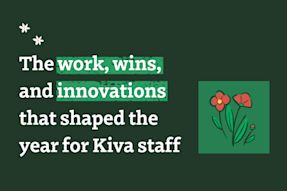As a skipper on an inland European cargo ship, Kiva lender Nathalie has plenty of time to contemplate while she’s at work.
Of course, overseeing the movement of goods around the waterways of Europe requires her utmost attention, but Nathalie often takes the peaceful moments on the ship to think about the state of the world and how she can help make it better for all.
“If I was a millionaire I would love to help everybody,” she writes from her home port in Antoing, Belgium, during one of her recent stints on land.
Nathalie joined Kiva in April 2021 after reading about it on the blog soChicken, a site hosted by Dutch social impact influencer Jelle Hermus, who promotes a more loving society by bringing his readers simple actions that improve people’s lives and the environment.
“He mentioned Kiva a couple of times when it came to ‘giving better presents,’” recalls Nathalie.
“I loved the idea, especially the fact that it’s a loan to help someone and you don’t just give it.”
As with many Kiva lenders, the efficacy of loaning directly to a person resonated with her.
“It’s in agreement with the way I think,” she muses. “I would never accept a donation, but I would accept a loan. This way I would keep my dignity and would not owe something to someone. Nothing but paying back the loan.”
‘A little becomes a lot’
“That’s the beautiful part; I don’t know them, I’ve never been there, but I can help them”
Since becoming a Kiva lender, Nathalie has made a total of 23 loans in 14 countries. Her original deposits of $402 have been repaid and relent to new borrowers, bringing the total amount of money she has lent to $575.
“I love the fact that it’s not helping one person but that it goes on and on,” she says of the compounding impact of the relending cycle.
“I loan because ‘little by little, a little becomes a lot’—that’s a Tanzanian proverb I think suits Kiva very well.”
The ship captain, whose routes are for the most part limited to the inland rivers leading to French ports, also lends because it deepens her connectedness with people around the world and the places they live.
“That’s the beautiful part; I don’t know them, I’ve never been there, but I can help them,” she notes.
“In that way it connects me to all of these countries.”
Supporting the human behind the loan
 One of Nathalie’s first loans went to Elizabeth, a maize farmer in Kenya.
One of Nathalie’s first loans went to Elizabeth, a maize farmer in Kenya. When it comes to her lending practices, Nathalie says checking in with her loans and considering new borrowers is “addictive.”
She reads each borrower story carefully and finds herself drawn to loans posted by single mothers who are seeking ways to better the lives of their kids. One of her first loans went to Elizabeth, a widow and maize merchant in Kenya who used Kiva loans to send her seven children to school.
“I often look at the family-composition. A mother who is all alone and has to raise her children, that’s hard,” she says, adding that she tries to connect with the human behind the loan.
“I take my time to try to find the person that gives me a little sparkle.”
She is also inspired by the ingenuity and perseverance of those still working to meet basic needs, citing the award-winning 2019 film “The Boy Who Harnessed The Wind”. Based on the memoir of Malawian inventor William Kamkwamba, the film tells the story of a low income young man who brought electricity and fresh water to his village by building a wind turbine out of discarded junk.
“Until then I just took water for granted. After that I lent to enable people to have drinking wells nearby.”
Climate change caused by industrialization is also a factor in the way Nathalie chooses her loans. Spending so much time on inland waterways, she witnesses first-hand disastrous weather conditions and polluting effects of chemical run-off from fertilizers.She points to documentaries such as “Kiss the Ground” and “The Biggest Little Farm” as resources that educate people about the dangers of commercial agriculture.
“I hope farmers around the world will not go to the same massive agriculture as in the U.S. and Europe. I hope they will try to do it without chemical fertilizers and do it in a natural way.”
An effective impact
Lending on Kiva has opened up the way Nathalie thinks about making an effective impact, especially for people who are financially excluded from loans and other banking services.
“Before, I didn’t really think about how people in other countries were able to start a business or dig a drinking well,” she says. “When there is no bank that wants to give you a loan, you might have to borrow from people you prefer to avoid.”
Becoming a Kiva lender has also helped foster connections closer to home: Nathalie recently gave a Kiva Card to her sister, and the two often combine forces to create an even bigger impact.
Read more: Kiva’s holiday guide to impactful gift-giving
“We regularly talk about it and choose our loans together,” describes the skipper of their shared activity.
“We’re not rich, but on our little level we can help people achieve a better life.”
Want to help create a positive impact? Become a Kiva lender! A little becomes a lot through Kiva.
PREVIOUS ARTICLE
Umpqua Bank celebrates $1 million in loans for women and BIPOC entrepreneurs through Kiva →NEXT ARTICLE
Building the economy within Rwanda's refugee camps →














